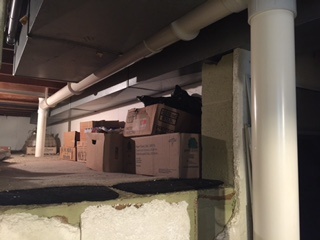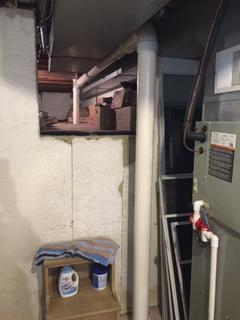Removing Radon Gas from a Crawlspace
If your home tests elevated for Radon Gas and there is a crawlspace in your basement, than that may be one of the ways radon is seeping into your home. A crawlspace with exposed soil flooring will have no barrier to prevent radon entry.
The cancer causing gas will seep through the floor and into the occupied area of your home. The best way to prevent radon gas entry through a crawlspace is to install a radon mitigation system.
Want more information about your radon mitigation options? Read our blog post "The Five Benefits of Installing a Radon System in the Attic."
Table of Contents
- Crawlspace with Dirt of Gravel Floors
- Concrete Floor Crawlspace
- Contact a Licensed Mitigation Specialist
Schedule a Free Radon Mitigation Quote
There are two ways to be sure that radon gas is not entering your home through a crawlspace.
Crawlspace with Dirt or Gravel Floors
Crawlspaces that contain dirt or gravel flooring will need to be sealed with an airtight membrane called a vapor barrier. Any personal belongings or debris will need to be removed from the contaminated area prior to the installation of the crawlspace membrane. If the gravel is sharp, a layer of tar paper may need to be placed over the floor before the membrane can be installed to  prevent tears in the plastic.
prevent tears in the plastic.
The plastic membrane will be sealed to the floor and walls to create and airtight barrier to block radon entry.
The radon mitigation system will be tied directly to the soil under the membrane creating a 24 hour vacuum that will constantly suck the radon through PVC pipping outside of the home.
Concrete Floor Crawlspace
A crawlspace that contains a concrete floor will require a different approach to remove radon. If the crawlspace contains cracks in the floor these will all need to be sealed to create a more air tight barrier. The radon mitigation system will be installed in the crawlspace by drilling a hole through the sub slab to create an access point to the soil underneath.
Depending on the layout of your home, the piping will be installed in the crawlspace and circulated internally into the attic of the home or externally above the eve line of the roof. Either option works just as efficiently as the next, typically it comes down to the homeowner's preference on where to put the fan.
Often times when there is a crawlspace involved there will need to be multiple suction points to make sure the radon is being removed from the home in the most effective way possible. The primary suction point is usually installed through the sub slab of the basement with an additional suction point in the crawlspace. Most of the time the two suction points can be connected with PVC pipping and only one fan will be needed to pull the radon from underneath the foundation of the home.
Contact a Licensed Radon Mitigation Company
If your home contains elevated levels of radon gas, you will need to contact a licensed company  to install a radon mitigation system to remove the radioactive gas. Not all homes contain a crawlspace, however that does not mean that your home is safe from radon.
to install a radon mitigation system to remove the radioactive gas. Not all homes contain a crawlspace, however that does not mean that your home is safe from radon.
If you have never had your home tested that will be your first step. Once you are made aware of the levels you can proceed with an installation if necessary.
Radon Eliminator has a team of specialists who are licensed with The Ohio Department of Health to test and remove radon from Ohio home.
They will be able to provide you with a detailed explanation of the removal process depending on your home's unique layout. If you have a crawlspace we can analyze how to effectively prevent radon gas infiltration.
Contact us today for a discounted radon test or free radon mitigation quote!





